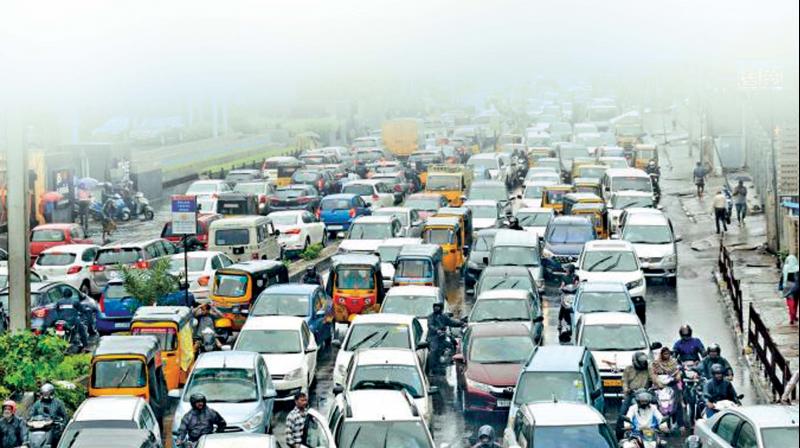Chennai, second in overall emissions: Study
It also stands second in fuel consumption and the total number of two-wheelers on the roads, the report released in Kolkata said.

Chennai: The Centre for Science and Environment has put out a report stating that citizens in Chennai make the longest trips in daily commute and the city stands second on overall emissions and thereby energy consumption among all metros.
It also stands second in fuel consumption and the total number of two-wheelers on the roads, the report released in Kolkata said. The report titled- 'The Urban Commute and how it contributes to Pollution and Energy Consumption' revealed that emission levels in Chennai and cities like Chennai- Bengaluru and Hyderabad are going the Delhi way. Delhi, however, remained the city with the most polluted air.
Anumita Roychowdhury, Executive Director, Research and Advocacy, CSE, said, “ air pollution is a national crisis and road transport is the sector showing the highest increase in emission of greenhouse gases. Although transport is the third largest contributor, with industries and agriculture being one and two, the rate of increase in its contribution to pollution is the fastest, which is bothersome.” At the same time, personal transport like cars and two-wheelers take up 40 per cent of total energy available for transport.
"Motorisation in India is explosive. Initially, it took 60 years (1951-2008) for India to cross the 100 million registered vehicles mark. However, the next 100 million were added in a mere six years (2009-15)," Ms Roychowhury said.
In the West, public transport is three things - accessible, attractive and affordable. The rich and poor alike use the public transport on a daily basis and personal vehicles are a bare minimum. This is to avoid traffic, but also to cut costs on parking fees, toll tickets and other such expenses. In fact, Rutul Joshi, Associate Professor, Department of Planning, CEPT University says in a vehicle’s lifetime, which is about 15 years, the costs incurred on tolls, payments and other such expenses are almost equal to the cost of the car itself.
Here, however, personal transport is a sign of wealth, social status. “The first thing someone buys is a car. Even if it is on a loan, it’s almost always a car,” says an activist, adding that the number of single-person four wheelers increase tremendously on the streets daily.
Two-wheelers, too, aren’t far behind. According to the study, Chennai has the highest number of two-wheelers amongst all metro cities. This is because of last-mile connectivity, experts say.
One could take the metro train, local bus, the MRTS trains or any other public transport, but the distance between the house and the nearest bus stop might be the reason they aren't availing public transport in the first place. The expansion of the city has happened in such a way that the periphery is radially away from the centre, therefore reducing the last-mile connectivity, they say.
However, all cannot be blamed on the system, believe some. “A lot of work is being done on non-motorised transport infrastructure,” says Daniel Robinson of Chennai City Connect. The Greater Chennai Corporation has received a tender to have 5,000 cycles on the street in phase I, he says.
Since the Bharat Stage emission standards (BSES) 6 (a Government of India standard to regulate the output of air pollutants including vehicles) 6 was introduced, the state government is also attempting to replace its entire bus fleet of over 4,000 buses. The common complaint is that the reason that the transport department incurs loses is because they over allocate buses on certain routes. However, Daniel disagrees. “This is not true. The total requirement is 10,000 buses. Where is the problem of over-allocation when we have only 4,000 buses,” he asks.
Another large problem is emission checks. About a decade ago, the transport commissioner had ordered vehicles plying in the city to carry the Pollution Under Control (PUC) certificates at all times.
“Though the Central Motor Vehicles Rules, 1989, states that every vehicle should get the PUC certificate every six months, it is not followed by a majority of the private vehicle owners,” says Bhargab Mitra, Professor, Department of Civil Engineering, IIT Kharagpur.
“The department has been able to enforce this rule on transport vehicles, as the vehicle-owners have to compulsorily produce the certificate at the time of renewing their permits and issuing fitness certificates. The private vehicle owners, however, do not have similar compulsions.”
Confirming that most non-transport vehicle owners do not renew the PUC certificate every six months, A Jai Kumar, president, Tamil Nadu Vehicle Emission Check Centre Association, in a report said that on an average only 200 vehicles undergo emission checks every month at each of the 55 testing centres in and around Chennai.
